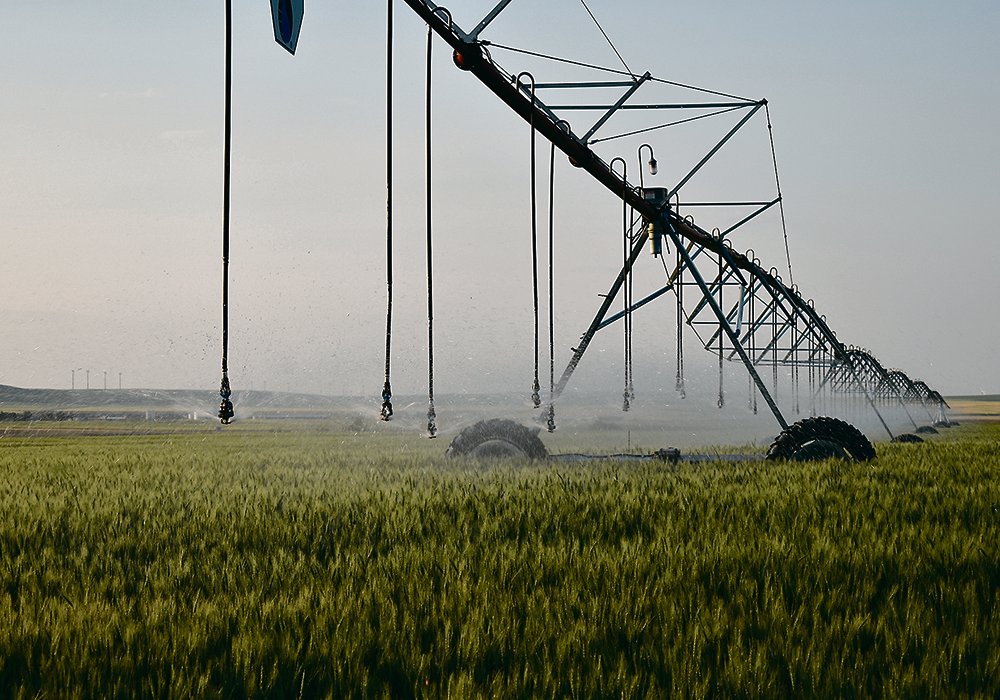Irrigation pivots work overtime this summer

Most irrigators have had adequate access to water during the drought, and many say their crops remain in good shape
Pivots have run nearly non-stop this summer on the portion of Anthony Eliason’s farm near Outlook, Sask., that is irrigated.
About a quarter of Golden Dee Farms, or 1,250 acres, is irrigated and typically canola, dry beans, flax, fababeans and wheat are planted on that land.
This year, Eliason said he seeded higher value crops under pivots, including most of the canola, and put wheat on dryland.
“The irrigated land is looking great,” he said last week. “With the knowledge we will have water we can try for higher yields.”
The dryland crops, on the other hand, don’t look so good.
“The dryland crops are poor and maturing early due to both heat and moisture stress,” Eliason said. “Early-seeded dryland peas looked great at first but are struggling to fill pods in this heat.”
The Eliasons put 1.25 to two centimetres of water on each acre each week, with the higher volumes just before flowering and during podding. Lower volumes are applied during the heat to prevent stress on the crop and cool it down.
“This year is higher than normal, since we are running the pivots almost non-stop due to no rain since early June,” he said of water application. “The pivots only have stopped for fungicide application and repair since mid-June.”
But irrigation is no guarantee of a harvestable crop.
Aaron Gray, president of the Saskatchewan Irrigation Projects Association, has five pivots on land near Eyebrow but a large hailstorm July 11 hit four of the fields.
“Two of them are completely written off,” he said. “Two were canola in full blossom and the dryland corners won’t likely come back.”
That bad luck aside, Gray said this year shows the value of having access to water.
“Our irrigated crops are looking really good. The heat expediates plant growth and you need moisture to keep the crop fed,” he said. “We’re definitely using more water right now because you’ve got to keep up to the crop demand.”
That doesn’t mean irrigators are using more than they need. Each is allocated 12 inches, or 30 cm, per acre for a season.
“It’s pretty tough to put 12 inches of water on in a season,” Gray said, noting it depends a lot on soil type.
Some are watering only at night to try to minimize evaporation losses, and heat stress is a concern even for crops that are watered.
In Manitoba, potato growers in some areas have had to move water long distances for their crops.
Dan Sawatzky, manager of Keystone Potato Producers Association, said after a dry winter and no runoff, the reservoirs many growers use as water sources didn’t fill or didn’t fill enough.
Some growers west of Portage la Prairie and near Carman and Winkler had to get temporary licences to pump water further, he said, and the Carman area will run short in a few weeks.
Growers in the main potato-growing region of Carberry, Glenboro and Treherne use the Assiniboine River delta aquifer.
“They are fine. It’s still been a struggle to keep an adequate supply of water,” he said.
All regions need a good timely rain to finish up the crop, Sawatzky added.
In Alberta, at least one irrigation district has increased how much water its members can apply.
David Westwood, general manager of St. Mary River Irrigation District, said his district is sticking with the 16-inch allocation.
“Overall, I would say our system is working and meeting demand,” he said.
Heat stress is a concern because the hot temperatures came early and pushed crops ahead of schedule.
“Probably the relentless heat is not going to help at the end of the day,” he said.
Gray said there has been a lot of discussion about irrigation in Saskatchewan since the province announced its intention to expand producers’ access to Lake Diefenbaker over the next decade.
In a year like this he said the benefits accrue widely. Wildlife, for example, have access to a crop where they can hide from predators and seek relief from the heat.
He said not everyone who can irrigate will choose to, but he calculates the rewards this way: if canola is $20 per bushel and on irrigated land produces 60 bu. per acre, the farmer grosses $1,200 per acre. Inputs, including the pivot costs, vary but at $400 per acre would mean a profit of $800 per acre.
On the dryland corners of the same field, the inputs might be about $300 but with no yield this year the profit will be zero.
A pivot costs about $160,000 per quarter, or $1,000 per acre.
It’s not as simple as putting a pivot on land, Gray added. New irrigators have to learn about scheduling water use, variable rate application and other technical aspects of applying water.
Source: www.producer.com

